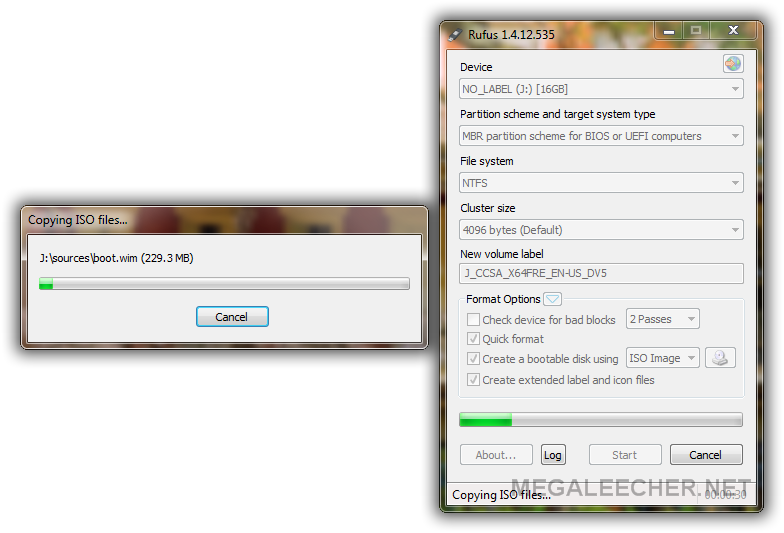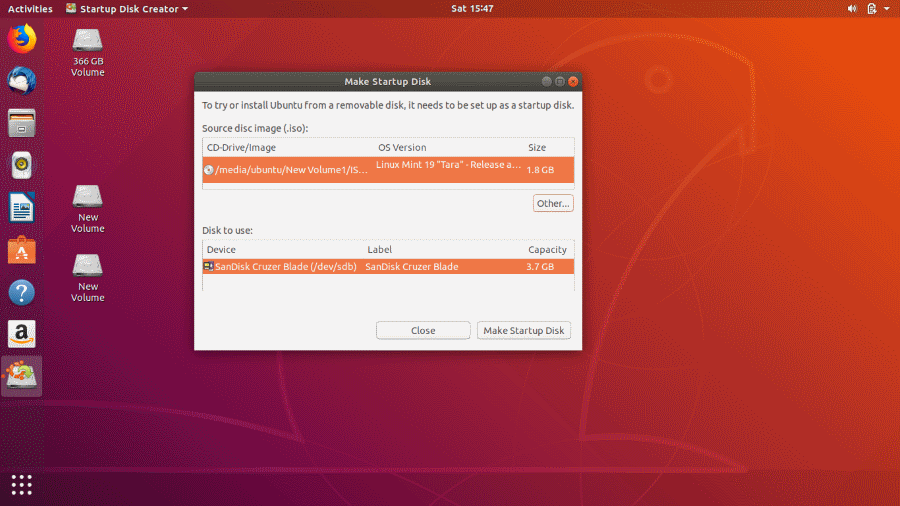
How To Make A Bootable Usb With Rufus On A Windows Machine For A Mac Machine
Here are the steps to create a macOS bootable USB media (Catalina) with GPT partition support on Windows 10 or 7/8.1 to rescue your Mac. Here are the steps to create a macOS bootable USB media (Catalina) with GPT partition support on Windows 10 or 7/8.1 to rescue your Mac. Aug 02, 2019 How to make bootable Pendrive for Ubuntu without using Command line-utility from Microsoft Windows. Now you will learn how to make bootable Pendrive for Ubuntu without using Command line-utility, but before that let me tell what you can do with a.
Windows 10 was launched in 2015. A bootable Windows 10 flash drive is just the vehicle you need if you haven’t upgraded or you want to install the latest version of Windows on another machine.
The USB drive will help you install a fresh copy of the OS (without being connected to the web if you have the Windows ISO file).
It is also an emergency repair utility to have around if your installation runs into a crash and you need to set up Windows from scratch. A clean install is always better than papering it with an in-place upgrade.
A bootable flash drive with the latest version of Windows is the simplest device to carry around in your pocket. It is also less damage prone than a DVD.
You can make your own bootable USB drive with the Windows 10 ISO file a series of commands from the Command prompt. But why bother when there are several easier alternatives available.
Use the Official Windows Media Creation Tool
You can easily create a bootable Windows 10 USB drive thanks to a handy official tool from Microsoft itself. The Windows 10 Media Creation Tool is easy enough to install and use for even the technologically challenged. Microsoft provides the steps to create the installation media, but these screenshots should make it easier for you.
1) Open the Windows 10 Download page. Go to the Create Windows 10 installation media section and click the Download tool now button.
2) Click on the downloaded software. Allow the User Account Control to run the tool. It will take a few seconds to prepare the Windows 10 Setup screen. Accept the license and move on to the next screen. Choose the
Create installation media option and then click the Next button.
3. Select the relevant language and Windows 10 version you have the license for from the selection field. Also, select either the 32-bit or 64-bit variant of Windows. Select your desired choices and click Next.
4. Insert an empty USB flash drive into a free USB port on the computer. The Media Creation tool will detect the USB drive and prompt you if it is not there. Make sure the drive is formatted correctly and has at least 8GB of available storage space as recommended by Microsoft.
5. Select USB Flash Drive and click the Next button.
6. The tool will then download the relevant Windows 10 files and create a USB bootable version of the operating system. Select the Finish button when the process ends.
This bootable drive can now be used to create a fresh install of Windows 10 on any machine.
Remember: The Media Creation Tool lets you create Bootable USB Windows 10 Drive for the Official general release Windows 10 Build only and not the Insider Previews. For the latter you will have to head to the section below and the excellent third-party freeware.
Use Rufus – The Best Bootable Drive Installation Utility for Windows
The Windows Media Creation Tool does both jobs simultaneously. It downloads the right version of Windows 10 and creates the bootable flash drive in one go. But what should you do if you have already downloaded the Windows 10 ISO and then need to create a bootable Flash drive from that back-up?
Take the help of Rufus. Rufus also allows you to create bootable installation mediums for Insider Preview builds.
I am assuming you have already downloaded the Windows 10 ISO. Plug in your pen drive to the PC. Ideally, the Windows 10 32-bit version will need a minimum of 4GB and the Windows 10 64-bit version will need 8GB.
Now, we need to just download and run Rufus to create the bootable drive. So, download the executable and run it – no installation is necessary. Rufus will prompt you to check for any updates to the software online; skip this if you have downloaded the latest version.
Configure Rufus to handle the installation. The settings are common to both 32-Bit and 64-Bit Windows 10 ISO files.
Device: Choose the bootable device you would like to install to.
Boot selection: Select the disk or ISO image option and then click the Select button and navigate to the location of the ISO file on your computer. This defaults the utility to create a bootable installation.
Partition scheme and Target system: MBR partition scheme for BIOS or UEFI-CSM
Volume label: Any name for the bootable installation. For e.g. Windows 10 64-bit ISO
File system: NTFS
Cluster size: Default value is 4096 bytes
Show advanced format options:
• Select Quick format as it works in most cases.
• Select Create extended label and icon files.
• Select Check device for bad blocksJasa download kaskus nightlife. to test the integrity of the Flash Drive. If you are sure that the drive is okay, then leave this unchecked as the test can slow down the installation.
Press Start and Rufus will go to work. It takes less than 10 minutes for the whole installation to finish.

Rufus is trouble-free. But if you face any installation issues then head to this GitHub support page for common troubleshooting tips.
Keep a Windows 10 Bootable Flash Drive Nearby
Thanks to the fade out of bulky DVD drives, portable USB drives are the preferred medium. You can see for yourself that making a quick bootable flash drive is quicker than burning the bootable ISO to a DVD. Also, Rufus and the Windows Media Creation tool aren’t the only two utilities available. Here’s a short list of freeware you can look into:
1. UNetbootin
2. Universal USB Installer
3. YUMI – Your Universal Multiboot Installer
4. RMPrepUSB
5. XBoot
In the end, do remember that if you do a clean install you will need the original Windows license key. Key that in after the installation and you are good to go.
More helpful articles:-
Have you ever been faced with the need to install a new operating system on a crashed PC but realize that you don't have the installation disc? For most people, such a case is always discouraging and disheartening because they know that the only way to install a new OS is to use an installation disc. Actually, all you need is a USB with a good capacity and a utility like Rufus. Rufus is a free, portable open-source utility that you can use to create bootable USB flash drives. Rufus is small in size, but it surprisingly has everything you need as far as the above are concerned.
Does Rufus Have a Mac Version?
Rufus is primarily a Windows application and currently, it supports 64 or 32 bit Windows XP/7/8/10 only. This means that you can not use Rufus on the normal Mac computers. If you need to run Rufus on a Mac, then it will be imperative for the computer to have a dual boot Windows installed on Mac. However, this is not an easy task at all.
To those in the dark, this simply means that you will need to have a Windows Operating system installed in your Mac computer. However, if you didn't want to have two operating systems running on the same machine so that you can access Rufus, there are quite a number of alternatives you can use to achieve the same functionalities of Rufus on Mac.
Rufus for Mac Alternative 1: UUByte ISO Editor
UUByte ISO Editor is by far one of the best ISO toolkits for those who want a seamless process in creating, burning, extracting and editing ISO images. Unlike Rufus, it has both Windows and Mac versions so you don't have to worry about not having Rufus for Mac or the need to install two operating systems in your Mac.
This ISO editor can effortlessly burn ISO image to DVD, CD or USB which you can then go ahead and use as a bootable disc for new installation. The tool is also versatile enough to create an ISO archive from folders or external sources, in addition to extracting or mounting ISO files to Mac or Windows computers. With over 220,000 users worldwide, it is a clear winner among the ISO toolkits available in the market today.
Why Choose UUByte ISO Editor
- Full ISO toolkit for Windows and Mac.
- Easily create bootable USB or DVD from Windows ISO.
- 5X faster burning speed.
- Excellent customer support.
How to burn ISO to USB on Mac using UUByte ISO Editor: Please download UUByte ISO Editor for Mac and install the app. Then drag and drop the app icon to Application folder so you can open the app from Launchpad. After that, insert a USB stick and click 'Burn' button at the first screen. Now import Windows ISO to the program and start burning ISO to USB by clicking 'Burn' button at the bottom of the Window. Finally, wait for 10 minutes to get the job done.
Rufus for Mac Alternative 2: UNetbootin
Universal Netboot Installer Unetbootin, is another cross-platform utility toolkit that makes a great alternative to Rufus on Mac. It has the ability to load and install various Linux distros on Mac. It is easy to use and supports a myriad of platforms. All you have to do is select an ISO file or the specific distribution you want to download and then simply choose the target drive. It also comes with a nice GUI, which further adds to the user experience during use.
Pros:
- Support Windows, Mac and Linux.
- Able to download Linux ISO within the program.
- Easily create ISO image from files or folders.
Cons:
- Non-native user interface.
- Lower success rate on new USB drives.
- Lack support for CD or DVD.
Rufus for Mac Alternative 3: Etcher
Etcher is another great Rufus alternative for Mac. It has been designed to allow you to easily and comfortably burn ISO images to USB drives and SD cards. The utility comes with an advanced interface which may be intimidating on first glance, but after going through the simple user guide, getting around to use the utility becomes a breeze.
Simply download this tool, launch it, and then choose the IMG file you are interested in burning. You will then select the location of the target USB drive or SD card and then wait for it to do its magic. It is lightweight and relatively fast, so you won't have to wait for a whole day for the burning process to end.
Pros:
- Polish user interface.
- Support USB drives as well as SD cards.
- Easy to use.
Cons:
- Being loaded slowly on startup.
- Get stuck at burning process easily.
- Poor support for Windows 10 ISO.
Verdict:
Rufus is a great application for burning ISO to USB. Unfortunately, there is no Mac version yet. So for burning ISO to USB on Mac, you have to use third-party alternatives like UUByte ISO Editor to get it done. The suggestions in this post almost do the same thing as Rufus on Windows so don't worry about the functionality. Go ahead and pick up the best one according to your experience.